 |
American History
The Cristeros – Part I
The Spaniards Land in Mexico
Luiz Siqueira Campos
During his recent visit to his hometown – Curitiba in the State of Paraná, Brazil - my friend Atila Guimarães again asked me to write something for Tradition in Action. I had made a first attempt in 2007, but was unable to continue the initiative at that time.
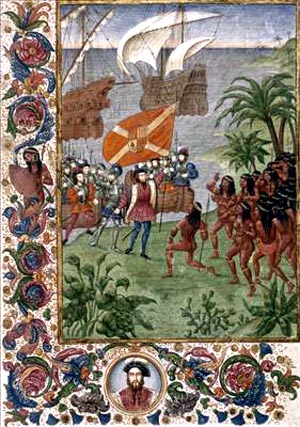
With Cortes' arrival the Spanish saga in the New World begins |
“What topic should I broach?” I asked. He proposed that I write a series of articles on an historic topic that never grows old for militant souls: the heroic saga of the Cristeros in Mexico.
The first word of the name of this site, Tradition, obviously relates in many ways to history, but what about the second, Action? The story of the Cristeros certainly fits the term.
My goal in taking on this topic, however, is not just to feed the reader facts, but to offer him a stronger fare – to solidify his convictions, steady his faith and support his march forward amid the growing chaos around us. To do this, in my exposition I will follow the famous Catholic trilogy: to see, to judge, and then to act. First, we must see, to try to know what happened, to present the historical facts. Second, we must analyze those facts, judging them according to the eternal principles taught by the Holy Church. Finally, we must act, applying these convictions to our aims, judgments and actions of our daily lives.
To address the theme of the Cristeros in this light, I will first establish some presuppositions with regard to Mexican history and psychology in the initial articles of this series.
Characteristics of the Aztec Empire
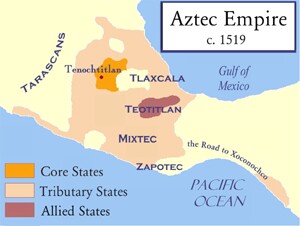
Above, the Aztec Empire at that time;
Below, its religion demanded human sacrifice
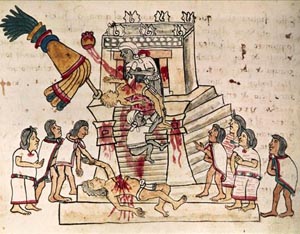 |
When the Catholic Spaniards arrived, the territory of present-day Mexico was dominated by a Nahuatl-speaking people, the Aztecs. Originally migrating from Northern Mexico, this people, through their superior warrior skills and organizational capacity, came to dominate in the Valley of Mexico and extend its power to both the Gulf of Mexico and the Pacific. It was not the first time in history when a nomad, hunter-gatherer people, entering the lands of a sedentary occupant, would become the ruler of the land.
What most strongly identified the Aztecs in history was their world view and its correspondent religion. Their world was not a stable one; it was in continuous danger of collapsing. Only through a never-ceasing effort could they survive and see the next day. Transferring this perspective to their religion, they established their sacrifices asking their idols for the sun to rise again the next morning. This conception, along with their savagery, resulted in human sacrifices. According to that primitive religion, blood had to flow to maintain their social order.
Even though human sacrifices were common in almost every ancient pagan religion, it is said that no people in History spilled so much blood in this horrible practice as did the Aztecs. It is certainly a violent and primitive practice that deserves every censure. However, I would wager that even those barbarian Aztecs throughout their entire history exterminated fewer people on their blood-drenched altars than the babies that are killed today in the wombs of mothers in hygienic abortion clinics. Yet we think that we live in a civilized epoch…
That original tendency toward bloody violence runs through Mexican history in some way as a trait of the people.
The psychology of the Spaniards and their first deeds
The Spaniards who came to Central America had been shaped by what may be the longest war in history: the fight to expel the Muslims from the Iberian Peninsula. From those woeful days in the 8th century when Muslim invaders crossed the Gibraltar and soon came to occupy almost all the Kingdoms of Spain, the fight never ceased.
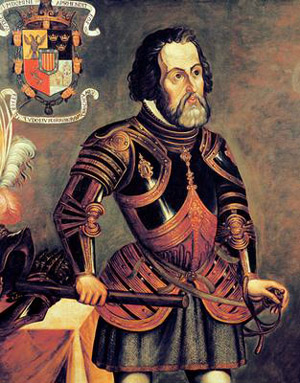
Cortés: a mark in the Spanish colonization of the Americas |
The heroic resistance of Don Pelayo, the chief of the miraculous victory of Covadonga in Asturias in northern Spain, gave those demoralized Christian warriors new hope and, with the help of Our Lady, became the departure point for the glorious Reconquista. This long war that lasted more than 700 years (711-1492) forged a generation of conquistadors who, soon after the conquest of Granada (1492), set sail for the New World. Despite some censurable weaknesses and moral excesses, they were undoubtedly a generation of brave and resolutely Catholic men sincerely dedicated to expanding the Kingdom of Our Lord Jesus Christ.
When Hernán Cortés landed in Yucatán in February 1519, he had only 11 ships, 500 men, 13 horses and a handful of cannons. With this, he prepared to face the entire Aztec Empire that ruled over more than 20 million people. To prevent desertions, he ordered his ships to be set on fire – a chivalrous deed that earned him the admiration of even his worst enemies. For himself and his soldiers, only one choice remained: victory or death!
Both a shrewd politician and an implacable man of war, Cortés took advantage of the deep discontent that simmered in the Aztec Empire. Encouraging conquered tribes to revolt against their rulers - and thus accompanied by about 3,000 Tlaxcalteca natives, Cortés and his men destroyed Cholula, the second largest city in Central America. On November 8, 1519 the Spaniards with their ever-expanding army were received by the Aztec emperor Montezuma II in his capital, Tenochtitlan.
Beyond the native enemies, Cortés had to face internal deceits and uprisings. For example, the Spanish governor of Cuba, moved by intrigues and jealousy, sent troops to defeat Cortés, but the latter convinced them to rally to his side in the conquest of Mexico. One can see the force of the personality of this great warrior and his unswerving determination to conquer.
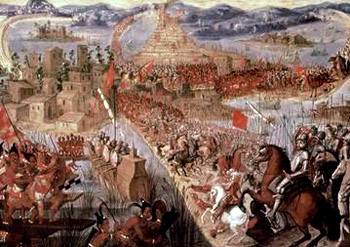
The Battle of Tenochititlan in 1521 |
He also faced another type of difficulty: the imprudence of his subordinates. One of the lieutenants of Cortés carried out a massacre in the temple of Tenochtitlan, triggering a local rebellion. Lacking the support of Montezuma, the Spaniards were forced to withdraw to Tlaxcala in July of 1520 after a battle where they lost 840 men.
Soon, however, Cortés recovered from that defeat. Bolstered by Spanish reinforcements, he was able to make the siege of Tenochtitlan, the final, decisive battle that led to the downfall of the Aztec Empire and marked the end of the first phase of the Spanish conquest of Mexico.
The heroic character of Cortés and his legendary spirit of challenge are traits that can be seen throughout Catholic Mexican history, especially in the glorious episode of the Cristeros.
However, to define the psychology of the Mexican people in general and the Cristeros in particular, I still need to address a fundamental episode of their history. It is how the Queen of Heaven took the conversion of Mexico into her own holy hands.
Our Lady of Guadalupe will be the topic of our next article.
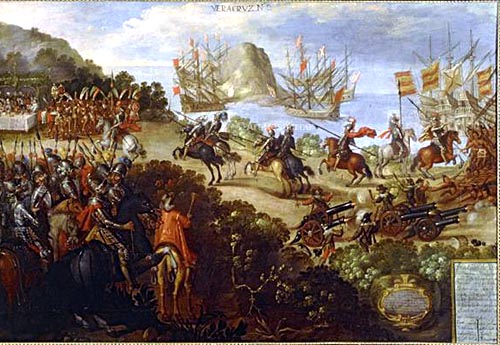
The arrival of Cortes in Veracruz and his reception by Montezuma's ambassadors |

Posted January 16, 2009

Related Topics of Interest
 Catholicism in Colonial America Catholicism in Colonial America
 La Conquistadora: Our Country's Oldest Madonna La Conquistadora: Our Country's Oldest Madonna
 Ven. Antonio Margil of Jesus: Apostle of New Spain and Texas Ven. Antonio Margil of Jesus: Apostle of New Spain and Texas
 The First Thanksgivings Were Catholic The First Thanksgivings Were Catholic
 Defending the Crusades Defending the Crusades
 The Swan's Song of Galileo's Myth The Swan's Song of Galileo's Myth

Related Works of Interest
|
|
History | Home | Books | CDs | Search | Contact Us | Donate

© 2002-
Tradition in Action, Inc. All Rights Reserved
|
 |
|